Sun's W2100z Dual Opteron Workstation
by Kristopher Kubicki on October 27, 2004 12:05 AM EST- Posted in
- Systems
Synthetic Benchmarks
Spec Viewperf 8.0.1 (GCC 3.4.2)
SPEC released their newest benchmarks just a couple of months ago, and we have been doing our best to validate SpecViewperf 8.01 as our main synthetic benchmark for some time. Our Viewperf was compiled via GCC 3.4.2. Much to our surprise, Viewperf 8.0.1 compiles without much tweaking. We only needed to edit the Makefile to change a few X11 lib references from lib to lib64 (we are running a 64-bit environment).You may wish to check out Anand's analysis of the FX-55 processor. Anand has a very good breakdown of each individual test, and what they mean. Do keep in mind that his analyses are done in a 32-bit, single CPU Windows environment and are very difficult to assess comparatively next to our SMP Linux tests.
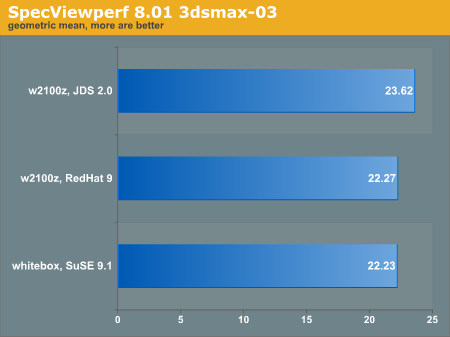
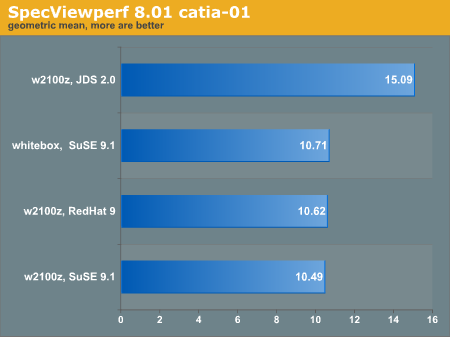
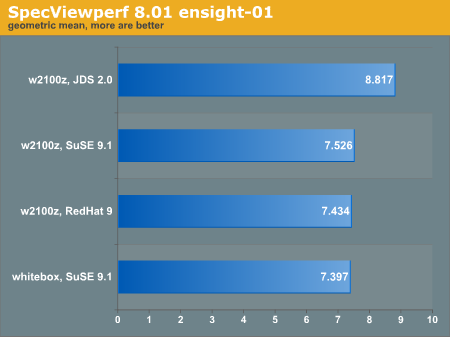
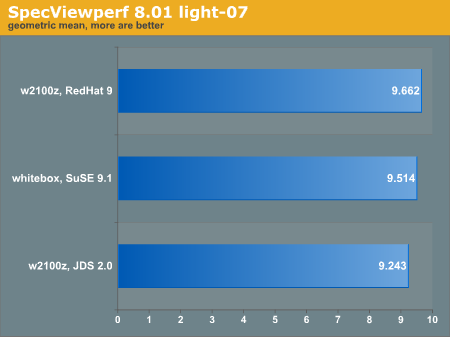
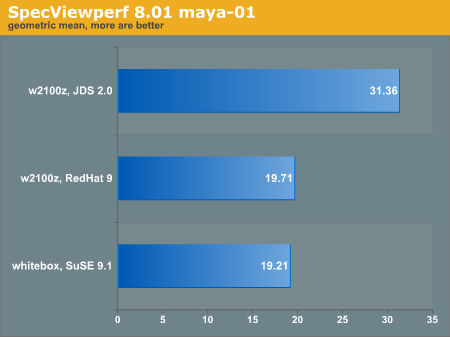
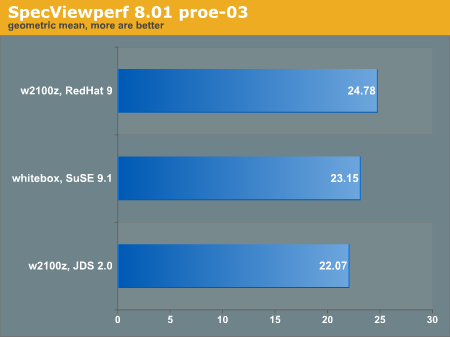
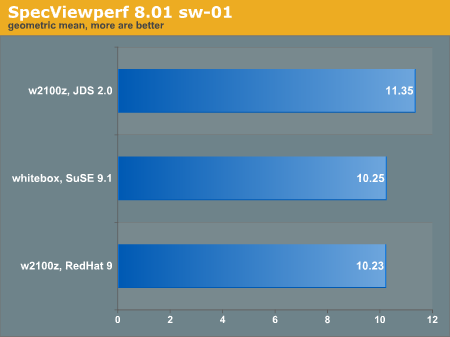
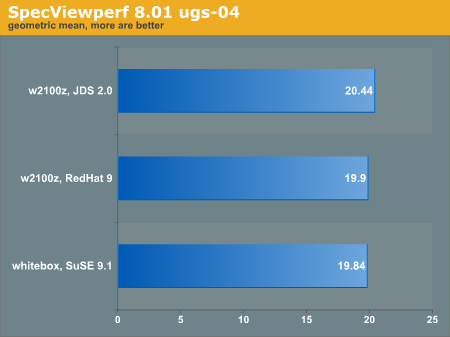
We found some very interesting results here. Almost all of our applications favored the 32-bit Linux 2.4 kernel over the 64-bit Linux 2.6 kernel! As you will see in our next few benchmarks, the 32-bit JDS platform actually performed poorer than our 64-bit platforms in almost every instance. While SPEC's benchmarks are the industry standard, we put more weight on real world rendering benchmarks, like Shake and MentalRay, which you will see on the following pages.
When compared to Anand's windows benchmarks, some applications favor our Linux setup thoroughly, although they could be benefiting from our dual processor setup. In any case, they are not particularly comparable as we are comparing "32-bit Windows" apples to "64-bit Linux" oranges. Perhaps, we will explore the differences between the performances on the two OS's again in the future. Also keep in mind that Anand uses a PCIe Radeon X800XT video card whereas we are using an AGP Quadro FX 3000. Differing video cards will change the results significantly.
We attempted to run Viewperf 7.1.1 as well, but we ran into several issues. The first time that we ran 7.1.1, the machine actually rebooted with no errors or warnings. We suspect something may have overheated, but there were no indications of that from our thermal tests that we ran after the reboot. Faulty code may also be to blame; the benchmark always crashed 2/3 of the way through on our RedHat 9 workstation.










47 Comments
View All Comments
najames - Friday, October 29, 2004 - link
I use a Sunfire V440 daily at work. It is a 4cpu large entry level server seen here.http://store.sun.com/CMTemplate/CEServlet?process=...
I program daily on mainframe, Solaris, and PC. Benchmark programs I wrote took 38cpu seconds on the mainframe, 38cpu seconds on my PIII pc, 17cpu seconds on Solaris. Four programs submitted at once on the the mainframe took 38cpu seconds but wall time was hours, the PC choked, the Solaris server still did them in 17cpu seconds each in about the same wall time. The Solaris server didn't slow down, period. We have combined large programs that individualy would sometimes crash on the mainframe and the Solaris Unix server burns through them even with temp space going over 12gigs druing processing.
If the Sun Opteron server is anything like my little Sunny, they sould do very well.
Reflex - Friday, October 29, 2004 - link
*laff* Something tells me thats not the case.My curiosity is just that since these are obviously relabels, I am wondering who the original manufacturer is as the hardware is excellent and it might be nice to be able to acquire these for white box systems.
morespace - Friday, October 29, 2004 - link
Egad. You're absolutely correct. I didn't notice the daughterboard arrangement in that picture at first. It looks flat. But looking more closely at the placement of chips and capacitors on those motherboards, it's more than a family resemblance - they appear identical!I sense a conspiracy.
The hard drive enclosures appear different for what it's worth. Who makes these really? Apple?
Reflex - Friday, October 29, 2004 - link
I take that back, that is the same as the one I have on my bench, however their cabling is a bit more messy.Look closely. Anandtech did not show a straight out picture from the same angle, but thats the same motherboard in more or less the same chassis with a few modifications. The CPU, chipset, Adaptec chip, PCI and AGP slots are all in the same places on that board, both use the daughtercard method for the CPU, etc.
Thats why I am asking who actually makes that board and case, someone is preconfiguring the servers and Sun/IBM are labelling and reselling them.
Reflex - Friday, October 29, 2004 - link
That is not the same Intellistation that I have on my lab bench. I'll look up the model number when I go back in, but seeing as its friday night that won't be till monday.morespace - Friday, October 29, 2004 - link
Reflex, what are you on about? Here's a picture of the insides of an IBM Intellistation A Pro:http://www.digitalcad.com/articles/viewarticle.jsp...
Tell me, how does this look like a w2100z?
Nsofang - Friday, October 29, 2004 - link
Zealots on both sides always mess up any discussion. This is a review about the Sun WORKSTATION, yet punks bring in supercomputer arguments. WTF!! is wrong with you guys! If anything bring in arguments/discussions about comparable hardware G5's/Itaniums/NEC/SGI, something that adds to the discussion, not subtract.slashbinslashbash - Thursday, October 28, 2004 - link
#33: You're right, for "general purpose computing" FLOPS is a pretty bad measure, but you've just changed your argument. For "high-end workstations" (what this argument is supposedly about) FLOPS can be *very* relevant, depending on the application.#34: I meant "nothing special" in terms of how supercomputing clusters are normally hooked up. Just a few years ago, Gigabit Ethernet cards cost $200, and their most prominent application was in supercomputing clusters.
Reflex - Thursday, October 28, 2004 - link
#37: Yeah, I know, I was in a mood yesterday or I wouldn't have let him get me into it. ;)And you just made the point I was trying to make. While price can be an issue in the corporate space, its only the deciding factor when all other factors are equal. I was not even trying to get into a Mac vs. PC debate, this really has nothing to do with Mac's.
I do want to know who is building these workstations though, because its not Sun despite the label.
bob661 - Thursday, October 28, 2004 - link
Reflex,He's trying to pull you off the subject. Supercomputers are irrelevant in this discussion. The thread is about workstations. Sun markets workstations. Apple does not. I know our company doesn't care about a couple hundred or even a couple thousand dollar difference if the service is impeccable and the workstation performs the task without headaches.